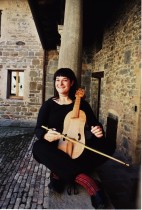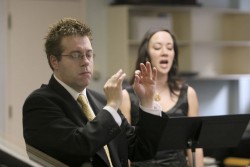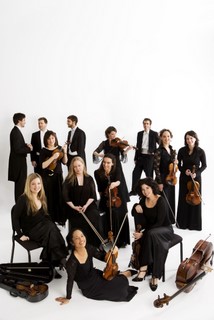Summer Samplings
 Thinking of going on an early music treasure hunt this summer? Here are some ideas for you.
Thinking of going on an early music treasure hunt this summer? Here are some ideas for you.
If your travel boundaries lie within Toronto and the GTA, you could spend the whole summer sampling a variety of styles and genres in many different programmes:
The Italian singer/instrumentalist Viva BiancaLuna Biffi (featured in the June early music column) presents her one-woman show, “Fermate il Passo,” a programme of Italian frottola in which she sings universal tales of love – its euphoria and torments, its ultimate triumph over adversity – while accompanying herself on the viola d’arco. This Music Mondays concert at the Church of the Holy Trinity takes place on July 5.
Beaches Baroque, a duo made up of baroque violinist Geneviève Gilardeau and lutenist Lucas Harris, presents “The Bach/Weiss Sonata.” The featured work is a seven-movement sonata for violin and lute supposedly by Bach, but striking in that the lute part began life as a sonata in its own right by Bach’s friend, the virtuoso lutenist Leopold Weiss. As well, more music by Bach, Weiss and Hagen will be presented, on July 10 at Beaches Presbyterian Church.
Hildegard von Bingen’s music broke the boundaries of expression for its time, and sounds amazingly modern today. The soaring chant of this 12th-century abbess can be heard on August 8 at the Church of Saint Mary Magdalene, sung by a group that’s been acclaimed for its performances of medieval music and Gregorian chant. The five-voice women’s ensemble Schola Magdalena is led by artistic director Stephanie Martin.
And sprinkled through the ambitious Summer Music in the Garden programme of the Toronto Music Garden – a concert almost every Sunday and Thursday from now till late September – are the following hour-long programmes, each one featuring a different aspect of early music:
July 4: On the day before her Music Mondays concert (described above), Viva BiancaLuna Biffi’s imaginative show “Fermate il Passo” can be heard here too, in this lovely outdoor setting.
July 15: “In Four Hands, Twenty-Nine Strings,” baroque violinist Linda Melsted and guitarist Terry McKenna explore a whole range of styles from the 17th to the 20th century – old English dance tunes, an opera overture, tango and more.
August 12: “Inspired by Cremona” presents some of the bold new music created to showcase the unsurpassed perfection of the stringed instruments crafted by 17th-century Italian makers. Music by Farina, Merula and Castello will be performed by baroque violinists Patricia Ahern and Linda Melsted, harpsichordist Borys Medicky and lutenist Lucas Harris.
August 22: In “Masque of the Garden,” musicians of the Toronto Masque Theatre, actor Derek Boyes and baroque dancer Dorothea Ventura celebrate the Music Garden itself, with music and dances that inspired the six sections of the garden.
August 26: “Able was I ere I heard Abel” is a tribute to the 18th century’s last great gamba virtuoso, Carl Friedrich Abel. Gambist Justin Haynes and baroque cellist Kate Bennett Haynes present music by Haydn, Schaffrath, and Abel himself.
September 2: In “Bach at Dusk,” cellist Winona Zelenka’s six-year odyssey through the Bach solo cello suites is fulfilled, with her performance of the Suite in C Minor (which is actually number five in the set).
It’s so easy to “catch the fire” of a summer festival – music springing up in various places, artists and concert-goers sharing the excitement of magical moments – and I urge you to work one or more into your summer plans. Here’s some of what you might find in various Southern Ontario festivals:
July 4: North of Toronto at historic Sharon Temple, Music at Sharon presents Les Voix Baroques, a celebrated ensemble specializing in vocal works from the Renaissance and Baroque. They’ll offer music by Charpentier and Carissimi in this imposing space.
July 18: Northwest of Campbellford, the Westben Festival presents the Toronto Consort in their presentation “Shakespeare’s Songbook.” The Consort uses the songs and dances of Shakespeare’s plays to engage the audience in the wonderful world of Elizabethan music: “music for fools, fairies and Falstaff.”
July 9-August 1: The Elora Festival takes place in a village with a spectacular setting along the Elora Gorge, north of Guelph. If you go, you’ll be able to hear four early music concerts: choral works with the Elora Festival Singers and collaborating artists on July 18 (Handel and Vivaldi) and July 22 (The Tudors); the delightfully daring group I Furiosi on July 24; and “Love: Sacred and Profane” on July 31 – a programme of renaissance music presented by Ludus Modalis Vocal Ensemble from France.
July 16-August 8: At the Festival of the Sound in Parry Sound, you can hear concerts as diverse as “Sound the Trumpet” (music for trumpet, soprano and piano by Purcell, Handel, Bach and Scarlatti) on July 29; Bach’s powerful B Minor Mass on July 30; and “Baroque on the Boat” (a morning concert on the M.V. Chippewa in Georgian Bay with the Festival Winds) on August 6.
July 19-August 22: At Stratford Summer Music, gems seem to be multiplying: Winona Zelenka, having recently recorded all the Bach solo cello suites, will perform each of them in separate concerts – and as several of these are now sold out, more performances are being added as I write. (Zelenka is featured as the cover story in The WholeNote’s June issue.) As well, Bach’s Coffee Cantata can be enjoyed in the appropriate setting of a coffee house (August 13, 14 and 15); and from it another event has been brewed: “Bawk’s” (alias Tiefenbach’s) Cappuccino Cantata (or The Lonely Barista) can be savoured the following week (August 20, 21 and 22).
July 24-August 7: If you find yourself in Ottawa this summer, you must take in some events of the Ottawa Chamber Music Festival. July 28: Les Voix Humaines (gambists Susie Napper and Margaret Little) present “Master and Pupil: Sainte-Colombe, the master, and Marin Marais, his pupil”; August 1: Ensemble Caprice explores an unlikely connection in “Bach and the Baroque Gypsies”; August 5: Helene Plouffe, Mark Simonds and friends present “Discovering the viola d’amore and chalumeau”; August 5: Ludus Modalis perform “Spiritual Songs and Psalms of the Renaissance” with music by Sweelinck, Estocart, Ferrabosco, Costelley and Le Jeune. (This list is not comprehensive, so do check the listings.)
As for me, I am enslaved by a gamba and a cat, neither of whom travels very well; so I’ll probably do most of my concert-going within the boundaries of Toronto. But you never know – don’t be surprised if you find me at any of the aforementioned events. And may your own treasure hunt be fascinating!
Simone Desilets is a long-time contributor to The WholeNote in several capacities, who plays the viola da gamba. She can be contacted at: earlymusic@thewholenote.com.




/Lucas Harris 1-area-172x162.jpg)
/Borys Medicky 1 1505-area-165x242.jpg)
/Julia Wedman 1-area-104x153.jpg)

